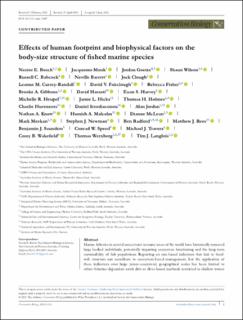Effects of human footprint and biophysical factors on the body-size structure of fished marine species
| dc.contributor.author | Bosch, Nestor E. | |
| dc.contributor.author | Monk, Jacquomo | |
| dc.contributor.author | Goetze, Jordan | |
| dc.contributor.author | Wilson, Shaun | |
| dc.contributor.author | Babcock, Russell C. | |
| dc.contributor.author | Barrett, Nevell S. | |
| dc.contributor.author | Clough, Jock | |
| dc.contributor.author | Currey-Randall, Leanne M. | |
| dc.contributor.author | Fairclough, David V. | |
| dc.contributor.author | Fisher, Rebecca | |
| dc.contributor.author | Gibbons, Brooke A. | |
| dc.contributor.author | Harasti, David | |
| dc.contributor.author | Harvey, Euan S. | |
| dc.contributor.author | Heupel, Michelle R. | |
| dc.contributor.author | Hicks, Jamie L. | |
| dc.contributor.author | Holmes, Thomas H. | |
| dc.contributor.author | Huveneers, Charlie | |
| dc.contributor.author | Ierodiaconou, Daniel | |
| dc.contributor.author | Jordan, Alan | |
| dc.contributor.author | Knott, Nathan A. | |
| dc.contributor.author | Malcolm, Hamish A. | |
| dc.contributor.author | McLean, Dianne | |
| dc.contributor.author | Meekan, Mark | |
| dc.contributor.author | Newman, Stephen J. | |
| dc.contributor.author | Radford, Ben | |
| dc.contributor.author | Rees, Matthew J. | |
| dc.contributor.author | Saunders, Benjamin J. | |
| dc.contributor.author | Speed, Conrad W. | |
| dc.contributor.author | Travers, Michael J. | |
| dc.contributor.author | Wakefield, Corey B. | |
| dc.contributor.author | Wernberg, Thomas | |
| dc.contributor.author | Langlois, Tim J. | |
| dc.date.accessioned | 2022-03-07T10:31:07Z | |
| dc.date.available | 2022-03-07T10:31:07Z | |
| dc.date.created | 2022-02-27T14:16:23Z | |
| dc.date.issued | 2021 | |
| dc.identifier.citation | Conservation Biology. 2021, . | en_US |
| dc.identifier.issn | 0888-8892 | |
| dc.identifier.uri | https://hdl.handle.net/11250/2983362 | |
| dc.description.abstract | Marine fisheries in coastal ecosystems in many areas of the world have historically removed large-bodied individuals, potentially impairing ecosystem functioning and the long-term sustainability of fish populations. Reporting on size-based indicators that link to food-web structure can contribute to ecosystem-based management, but the application of these indicators over large (cross-ecosystem) geographical scales has been limited to either fisheries-dependent catch data or diver-based methods restricted to shallow waters (<20 m) that can misrepresent the abundance of large-bodied fished species. We obtained data on the body-size structure of 82 recreationally or commercially targeted marine demersal teleosts from 2904 deployments of baited remote underwater stereo-video (stereo-BRUV). Sampling was at up to 50 m depth and covered approximately 10,000 km of the continental shelf of Australia. Seascape relief, water depth, and human gravity (i.e., a proxy of human impacts) were the strongest predictors of the probability of occurrence of large fishes and the abundance of fishes above the minimum legal size of capture. No-take marine reserves had a positive effect on the abundance of fishes above legal size, although the effect varied across species groups. In contrast, sublegal fishes were best predicted by gradients in sea surface temperature (mean and variance). In areas of low human impact, large fishes were about three times more likely to be encountered and fishes of legal size were approximately five times more abundant. For conspicuous species groups with contrasting habitat, environmental, and biogeographic affinities, abundance of legal-size fishes typically declined as human impact increased. Our large-scale quantitative analyses highlight the combined importance of seascape complexity, regions with low human footprint, and no-take marine reserves in protecting large-bodied fishes across a broad range of species and ecosystem configurations. | en_US |
| dc.language.iso | eng | en_US |
| dc.title | Effects of human footprint and biophysical factors on the body-size structure of fished marine species | en_US |
| dc.type | Peer reviewed | en_US |
| dc.type | Journal article | en_US |
| dc.description.version | publishedVersion | en_US |
| dc.source.pagenumber | 0 | en_US |
| dc.source.journal | Conservation Biology | en_US |
| dc.identifier.doi | 10.1111/cobi.13807 | |
| dc.identifier.cristin | 2005860 | |
| cristin.ispublished | true | |
| cristin.fulltext | original | |
| cristin.qualitycode | 2 |
Tilhørende fil(er)
Denne innførselen finnes i følgende samling(er)
-
Articles [3001]
-
Publikasjoner fra CRIStin [3025]
